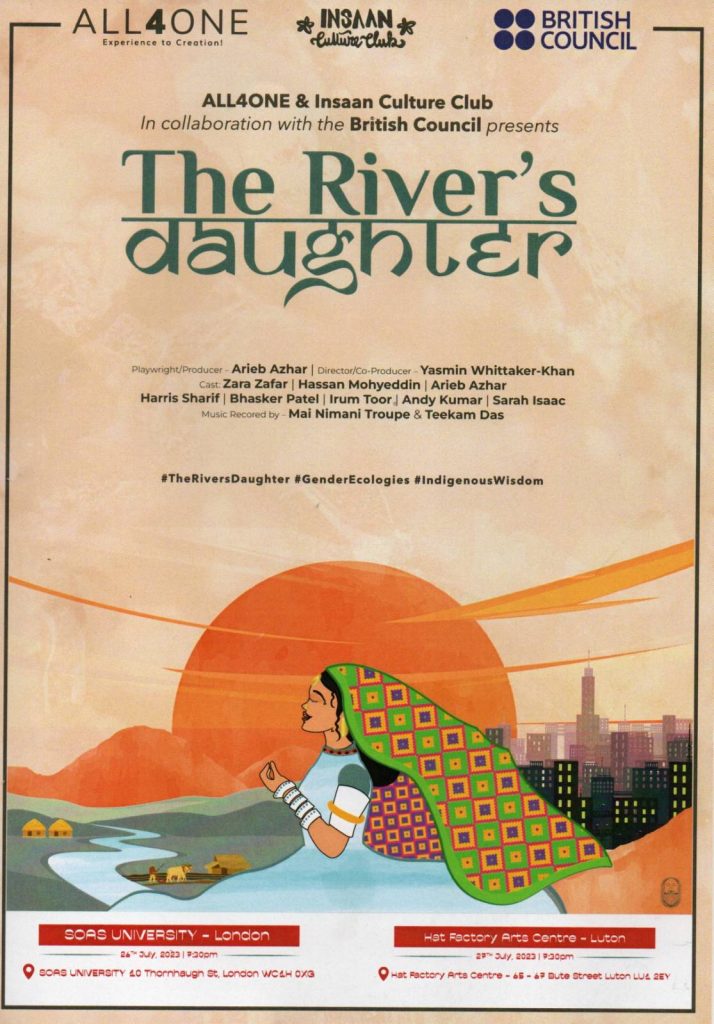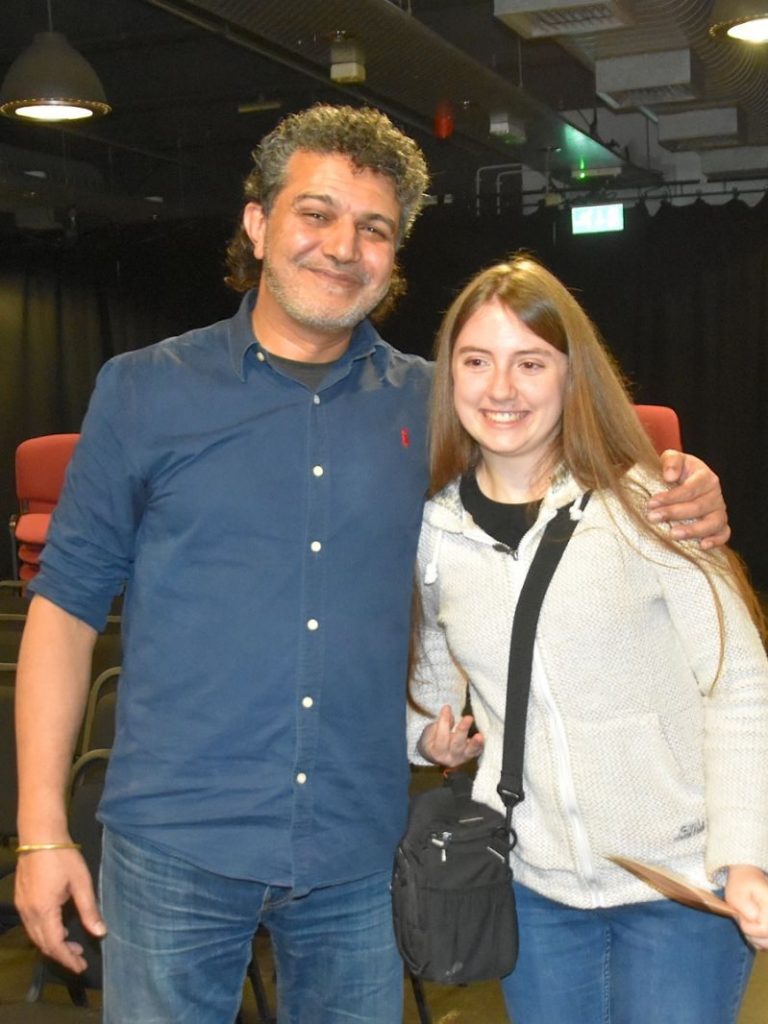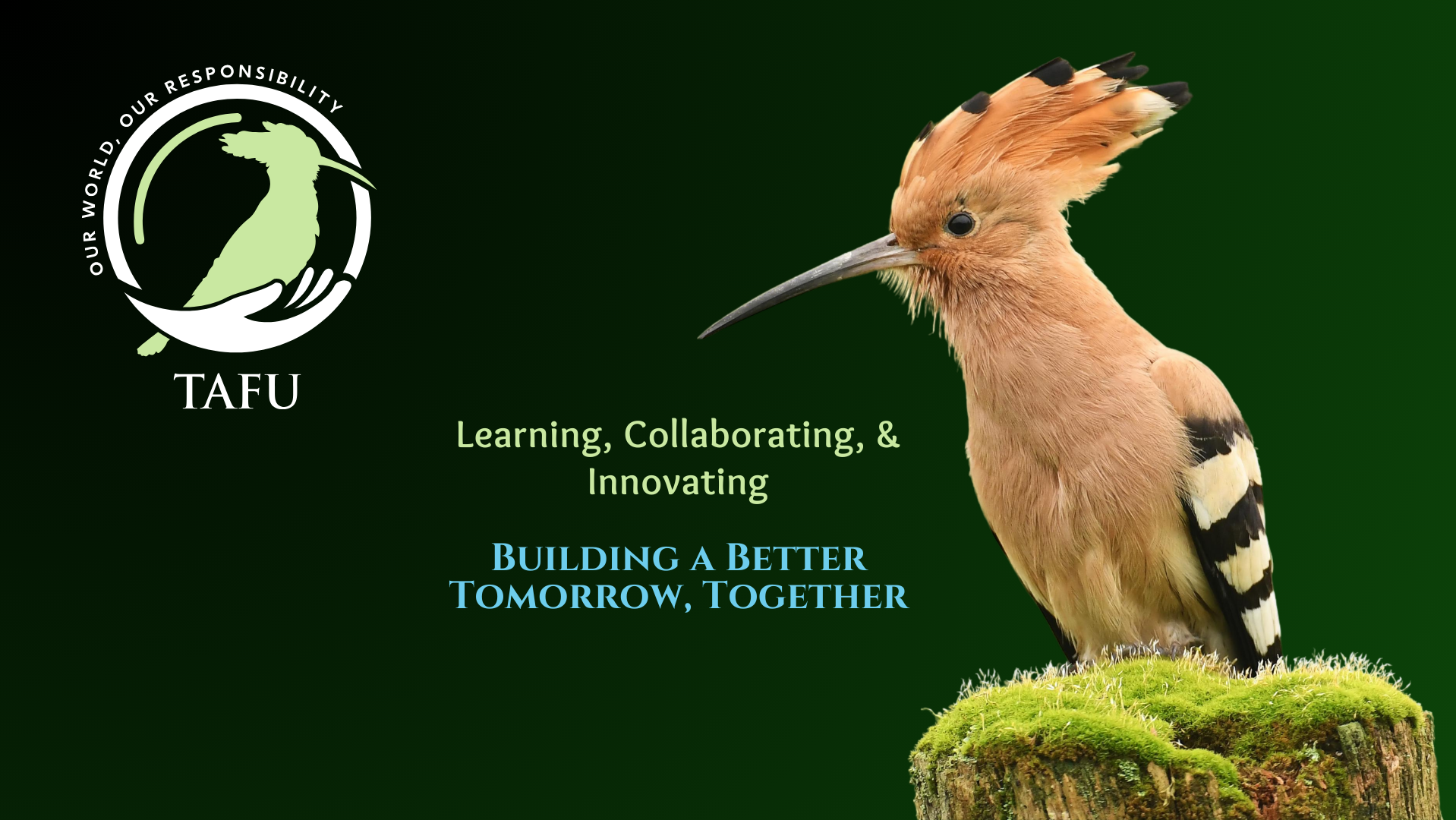The River’s Daughter
A play by Arieb Azhar

Abstract:
An Exploration of Social Responsibility, Nature Conservation, and Cultural Preservation
Arieb Azhar’s play, The River’s Daughter, is an evocative narrative set in a small Pakistani village, Bhulan Goth, on the brink of corporatisation. The story centres around Marui, an influential villager with a deep connection to nature, and Umar, a businessman intent on buying the villagers’ lands. The narrative is infused with profound lessons on environmental conservation, gender equality, and cultural preservation. In the face of an impending corporate takeover, Marui’s tenacity and bond with nature inspire the villagers to resist and secured a court order against the sale of their village land. Umar is challenged by the villagers’ resilience and Marui’s refusal to collaborate. After a monsoon causes a catastrophe, Umar joins the villagers, promising to rebuild the village, marking his transformation from exploiter to protector. The play employs symbolism and elements from Pakistani folklore, demonstrating an immense respect for cultural heritage. Furthermore, it addresses gender roles by positioning Marui as the beacon of strength, in stark contrast to the male-dominated corporation. The narrative challenges stereotypical gender norms and provides powerful female role models, from Marui to Mother Earth, echoing the theme of female empowerment.
The River’s Daughter is an engaging story and a call to action, urging individuals to contribute to environmental conservation, cherish their cultural heritage, and uphold gender equality. By intertwining these themes with a compelling narrative, Arieb’s work serves as a powerful conduit for social change. It is anticipated that his work will resonate on global platforms, continuing to spark thoughtful conversation and inspire action.
The River’s Daughter a title that conjures images of enchantment, ethereal beauty, and mysticism. Just yesterday, I had the privilege of attending a reading of Arieb Azhar’s riveting play, The River’s Daughter. This profoundly poignant and captivating narrative hinges on the actions and interactions of its two pivotal characters, Marui and Umar. Yet it also masterfully explores three underlying and significant themes: gender equality, preservation of local culture, and nature conservation. Hailing from Pakistan, the backdrop against which this play unfurls, Arieb stands as a fervent proponent and living embodiment of the same values that TAFU aspires to wake up in us all. This encompassing philosophy is grounded in personal responsibility, equality, and the preservation of cultural heritage and the natural environment, including our immediate habitats.
The play’s essence revolves around a village on the cusp of undergoing significant development. A businessman named Umar, allied with the mighty ‘Indispensable Corporation’, is determined to displace villagers and acquire their lands for construction. Yet, a small village called Bhulan Goth stands resolute in the face of this sweeping change.
At the heart of this resistance is Marui, a central figure within her community. She’s admired for her education, influence, and profound bond with nature, a connection she likens to a river coursing through her being, guiding her actions. This sentiment is one Umar later acknowledges as having lost touch with. Marui’s strength and determination motivate the villagers to retain their lands and secured them a court order against the sale of their land to the ‘Indispensable Corporation’.
This display of fortitude challenges the conventional perception of villagers as uncivilised and uneducated, more so when the source of this opposition is a woman. Taken aback by this unexpected resistance, Umar challenges and addresses Marui personally – a highly unusual action considering her status as a villager and his role as the project leader. When his employees approach Marui, their methods are invasive and oppressive, resulting in her refusal to meet Umar. Ignoring her resistance, they forcefully bring her to him.
Oblivious to his uncivilised conduct, Umar is taken aback by his employees’ behaviour and aims to engage Marui in a civilised conversation. He proposes to include her in his project, an offer she staunchly declines. Undeterred, Umar invites her to an event, where he offers her a job, and promising to leave her and her village untouched. Once more, she stands her ground and turns down his job offer. The project continues and the villagers of Bhulan Goth started their new eco-farming techniques that have so far been very successful (Umar often sent books about eco-farming to Marui to help in the development of their techniques). However, once the Monsoon came, some of the project’s construction sites were at risk of flood damage. The board decided, despite Umar’s opposition, to divert all the rain to Bhulan Goth. Just before Marui learns of the death of a woman, regarded as the mother of the village, due to the flood, Umar comes to warn her. However, she quickly leaves after receiving the news. Once the villagers have nearly evacuated, Umar returns asking to stay with them and promising to rebuild the village after the Monsoon is over, which of course is accepted by the villagers.
While on the surface, The River’s Daughter could be perceived as a charming tale of a wealthy businessman finding his path to a more grounded existence, the narrative is interlaced with profound lessons expertly woven by Arieb. At the heart of the play lie themes of environmental conservation and personal responsibility, both strikingly pertinent in today’s context.
Arieb, demonstrating his exceptional dedication to his craft, not only takes up the mantle of the play’s creator but also breathes life into one of its characters. It’s a testament to his versatility that he effortlessly transitions from the role of a playwright to a character within his narrative.
Beyond the world of theatre, Arieb is also a highly accomplished musician and singer. His melodies echo the richness of local culture and folklore, serving as melodic odes to tradition. His artistic work, whether through music or theatre, always emanates a deep respect and cherishing of local culture and folkloric traditions.
Just as his music nurtures the roots of cultural heritage, his play too amplifies key issues facing our society, prompting the audience to question and introspect. It’s not merely a tale woven for entertainment but a powerful commentary on the need for environmental conservation and the call for each individual to shoulder their share of responsibility. His work exemplifies that art is not only a means of self-expression but can also serve as a conduit for social change.
Despite the rich tapestry of characters in the play, the narrative is ultimately driven by the fierce resolve of Marui and the unified spirit of Bhulan Goth, her community. Marui emerges as a beacon of strength, single-handedly inspiring her village to resist the corporate takeover, successfully obtaining a legal ‘stay order’, helping Umar rediscover his own connection to nature, and leading the implementation of eco-friendly practices. Her actions reverberate beyond her immediate surroundings, despite the societal constraints she faces as a woman and villager. It is a testament to the power of one individual’s influence on not only those around them, but also on larger systemic issues.
Whilst the character of Marui is a beacon, it’s understood that not all of us are destined to be leaders. However, we can all make our own distinct contributions. Bhulan Goth stands as a representation of numerous villages destined for demolition in the name of progress. Yet, the collective determination of its villagers ensures its survival, not merely due to Marui’s negotiations with Umar, but largely owing to the unity they demonstrate. Their shared commitment to safeguard their home, the river, the environment, and the local wildlife brings about a profound change in Umar’s perspective.
This united front, their alignment in beliefs, and their willingness to act despite foreseeable obstacles, encapsulates the underlying message of the play – the importance of each individual playing their part. It is a potent reminder that unity, steadfastness, and personal contribution can indeed enact profound changes in our world.
Marui’s bond with nature runs deep; the vitality of the river that laps against the edges of her village serves as a lifeline, reflecting the overall wellbeing of the local ecosystem. Everything, from the smallest organisms to the largest beasts, relies on clean water for survival. The villagers of Bhulan Goth depend on nature for their sustenance, using it to cultivate their crops and nourish their livestock. However, their relationship with nature transcends mere utilitarian needs. Instead, it is a relationship of coexistence, an empathetic harmony that resonates with the ebb and flow of natural rhythms, a symbiosis that celebrates their oneness with the environment.
Indeed, cities are an integral part of our contemporary world, yet their existence should not sever our ties with the natural world. There are a myriad of ways to preserve and nourish our connection with nature. We can foster green spaces within our concrete confines, such as cultivating balcony gardens or frequenting local parks. As urban landscapes evolve, embracing more sustainable and eco-friendly practices, opportunities to engage with nature will only multiply. We can create spaces where nature thrives, allowing it to reclaim areas beyond our immediate use.
The resounding message emanating from this narrative is the imperative need to nurture our connections with nature, irrespective of our proximity. Whether we reside in bustling metropolises or rural idylls, we are never too far from the reach of wildlife and from the influence of natural elements. It urges us to continually strive for that connection, to recognise that our existence is interwoven with the natural world, and to honour this profound bond in our everyday lives.
Now, let us cast our focus on the significant theme of gender equality. The narrative deftly highlights a stark contrast between the overwhelmingly male-dominant ‘Indispensable Corporation’ and the community of Bhulan Goth. Within the Corporation, men assume all pivotal roles with the singular exception of Umar’s partner. However, in Bhulan Goth, we encounter a society where gender balance is not merely upheld but celebrated, and where all voices, irrespective of their gender, are valued despite some traces of lingering gender scepticism.
Throughout the play, Arieb imbues several female figures with the power and depth to serve as compelling role models. For instance, Hakima emerges with her wisdom as a lantern of nurturing energy in Bhulan Goth, her profound and warm influence on the younger generations, calling on personal responsibility, stands as testament to her strength. Further, her role as a potent source of inspiration to Marui is evident, Hakima is portrayed as mother wisdom and care to Marui and all villagers.
Moreover, Arieb creatively introduces other potent symbols of femininity into the narrative. Notably, Mother Earth and the Mother Queen Bee, with whom Marui shares a profound dialogue shortly before her abduction. They are intricately woven into the story, amplifying the theme of female empowerment.
These skilful incorporations of female role models and symbols enrich the narrative, further highlighting Arieb’s clever handling of the matter of gender equality in his play.
Marui, along with other villagers, consistently demonstrate a deep respect for these feminine symbols and role models. Umar’s choice of offering a pivotal role in the project to Marui, over a male counterpart serves as a tangible stand against the prevalent gender gap, even though Marui declines. Moreover, as the play unfolds, Umar evolves to not only value and act on Marui’s opinions but ultimately recognises her as his equal and, indeed, his moral superior.
The overarching message here encourages equality of treatment, open-mindedness to diverse viewpoints, and providing everyone an opportunity to express themselves. By failing to do so, we are not only mistreating the silenced individuals, but we also forfeit the chance to broaden our perspectives and evolve. The narrative urges us to recognise that every voice is significant and can contribute immeasurably to our collective growth and improvement.
Lastly, let’s delve into the play’s distinctive perspective on cultural conservation, a theme which is beautifully exemplified in the naming and roles of the characters. The characters of Marui and Umar draw parallels with a popular folktale from the Sindh province in Pakistan. In the folktale, Umar is a wealthy king who becomes enamoured with a village woman, Marui. Upon his orders, his servants attempt to bring Marui to him for marriage, yet she adamantly refuses, and the story evolves from there.
In his work, Arieb sheds light on the importance of cultural preservation purposely choosing these two characters to develop his contemporary story around. Despite being only lightly inspired by the folktale during his writing process, he felt it significant to name his characters after those from this traditional story, forming a crucial link to Pakistani culture. The play further develops this theme when Marui contends that the villagers would be unable to maintain their unique culture if they were forced to migrate to a city, where they risk being dispersed, and their culture obliterated.
Cultural preservation holds immense value for Marui as it does for Arieb, as the concept of eco-farming to her signifies a return to ‘the old ways’. This involves re-establishing a connection with their ancestral roots, integrating modern techniques with time-honoured traditions.
This commitment to cultural preservation is mirrored in Arieb’s own life, where he’s a musician celebrated for his extraordinary renditions of Pakistani music, and his deeply resonant voice. Music is a potent medium to engage with one’s cultural heritage and ensure its continuity. Arieb’s play acknowledges this, particularly in the scene where the tale of Umar and Marui is melodiously sung.
The overarching message from this analysis is the reminder that everyone, regardless of their origin, level of development, or urban living conditions, is a custodian of a unique culture. It is incumbent upon us all to take an active role in preserving and fostering our rich cultural legacies.
In conclusion, Arieb’s play offers far more than an engaging reading experience that lasts around one and a half hours. It is a multi-faceted tapestry of narratives that provokes thought, compels reflection, and imparts profound lessons. The play and its creator, Arieb, embody a harmonious blend of music and culture whilst skilfully incorporating themes of gender equality, nature conservation and cultural preservation. They are interwoven into a richly layered, compelling, and thoroughly enjoyable narrative.
As we look forward, the horizon is seemingly limitless for Arieb. One anticipates the publication of his play’s script, envisioning its enactment on the distinguished stages of Broadway and other prestigious global platforms. The prospects of future books and music from Arieb are also profoundly exciting. His unrivalled talent and inherent passion are the harbingers of the incredible artistry we can expect to witness in his future works.
Arieb’s distinctively insightful perspective on nature conservation, amongst many other themes, offers valuable lessons for us all. It serves as an invitation to appreciate these ideologies and adopt them in our daily lives actively. Let’s embrace the wisdom encapsulated in Arieb’s work, and begin to put it into practice, thus truly honouring the essence of his creation. In doing so, we become part of a greater narrative that respects equality, preserves nature, and cherishes our rich cultural heritages.
Stay tuned for an in-depth exploration of the play and a peek into Arieb’s future projects in the forthcoming exclusive interview with Arieb Azhar!
Nika S Underwood

Arieb Azhar and me
